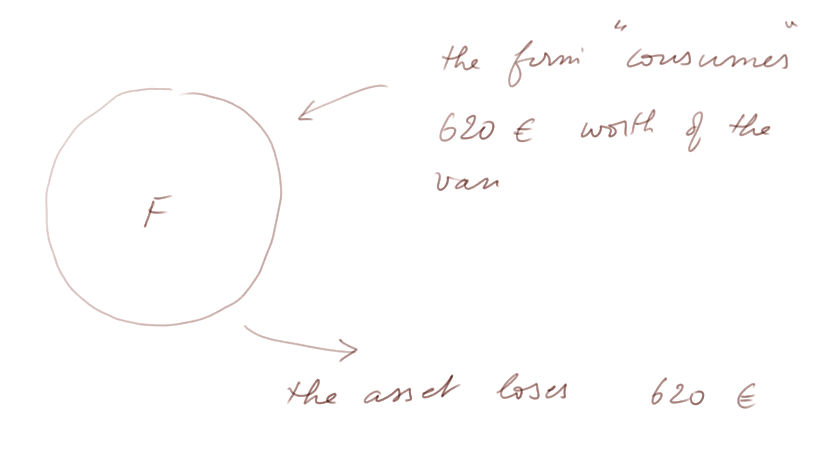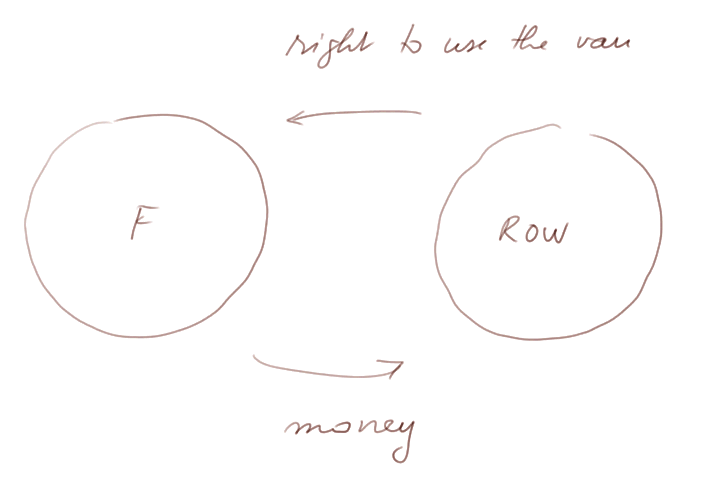General accounting
V. 21. Adjustments for amortization
Video
In the last lesson we saw the adjustment for inventory (also called adjustment for stocks). And we reached the following TB and IS:


The top part of the preliminary IS (on the right) is now correct.
But we are still missing some charges (= consumptions = costs) of the year.
The main charges missing are related to the fixed assets we acquired:
- the van, which we acquired for 3100€
- the machinery, which we acquired for 5000€
They are not "consumptions of the year" since they are going to be used for several years.
But they do lose value year after year.
Let's concentrate on the van first.
Suppose it wears out and becomes useless (and therefore worthless) in 5 years.
Then every year it loses, say, 1/5 of its original value, which was 3100€.
This yearly loss of value will be treated, each of the five years, as a transaction:

It is not, properly speaking, an exchange with the rest of the world, but it has exactly the same pattern.
Indeed, suppose, that instead of owning the van, we were renting it every year.
In that case it would be an exchange with the ROW (rest of the world):

But since we own the van, it is not the Cash account nor the Bank account (nor an IOU) which give out value. It is directly the asset account called "Van".
We still consume something: a part of the value of the van.
This explains why we shall credit an asset account, and debit a charge account.
Remark: this poses plenty of questions on:
- "what does it mean to own something?"
- "why own rather than rent?"
- "why use money to own something when we can actually rent?"
- "what is money?"
- "what is it to have credit?"
- "what's the difference between having access to credit, and having money?"
We shall not dig into them in this course, but you should begin to think about them.
Technique of amortization entry. Rather than crediting directly the van account, we credit a new account called "Amortization BS". This is in order to keep seeing in the Trial balance the raw value of the van. (Remember, accounting is a process of recording, and not deleting, useful information.)
And we debit a new account called "Amortization IS".
We debit a charge of 620€ in the Amortization IS

and we credit 620€ in the Amortizaion BS

Notice that it is a correct balanced double-entry.
Let's turn to the machinery, which we acquired for 5000€.
Suppose it loses its value (and becomes worthless) in 10 years. Then every year we "consume" 500€ off the value of the machinery.
The entries for the amortization of machinery are similar to those for the van:


Here is our new adjusted Trial balance:

And the new Income Statement

This Income Statement is final, or almost final. There may be some more transactions to observe and record (Provisions, Prepayments, Accruals). But when there are no more entries to be made, this is the final correct IS.
We shall study in the next lessons what are Provisions, Prepayments, and Accruals.
Amortization prorata temporis.
Suppose we purchased the van in the middle of the first year. In this case the 5 year amortization will end in the middle of the sixth year.
The first year we would amortize only 6 months, i.e. 620 x 6/12 = 310€.
This is the meaning of the latin expression prorata temporis: in proportion of the time.
Non linear amortization.
So far we have only talked about "linear amortization", that is amortization spread evenly over a certain number of years.
We can sometimes amortize with different charges each year. The most common is what's called "accelerated amortization". For instance, for a certain piece of equipment, we shall amortize it over 3 years, with the following yearly figures:
- First year: 50% of the acquisition value of the equipment
- Second year: 30%
- Third year: 20%
These choices of amortization schedule are to be discussed with the tax man, because they impact the net result each year: more amortization the first year reduces the net result before tax of the first year, and therefore the income tax.



